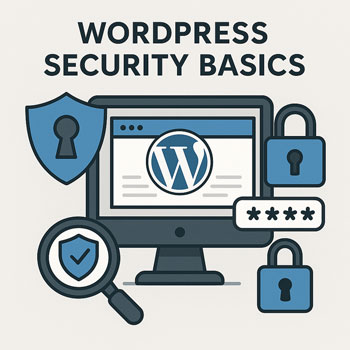
WordPress Security Basics
Module: Website Setup & WordPress Basics • Lesson: WordPress Security Basics
This lesson covers essential steps to secure a new WordPress website, including strong passwords, updates, user roles, and basic security plugin configuration.
Why WordPress Security Matters
WordPress powers millions of websites, making it a common target for bots and hackers. Securing your site early helps prevent:
- Unauthorized logins
- Malware injections
- Website defacement
- Data theft
- Performance issues
You don’t need advanced technical skills—basic security steps go a long way.
Core WordPress Security Principles
- Use strong authentication — secure usernames and passwords.
- Stay updated — always run the latest version of WordPress, themes, and plugins.
- Limit access — assign user roles properly.
- Install security tools — use firewalls, scanners, and login protection.
- Backup regularly — have a restore point if anything goes wrong.
Strong Passwords & Login Security
Use Strong Passwords
Weak passwords are one of the easiest ways for attackers to gain access. Strong passwords should contain:
- Uppercase and lowercase letters
- Numbers
- Symbols
- A minimum of 12–16 characters
Use a Unique Username
- Avoid using admin as your username—it’s the first target of attacks.
- Create a unique username for your Administrator account.
Enable Login Protection
Most security plugins allow you to:
- Limit login attempts
- Enable CAPTCHA
- Enable 2-factor authentication (2FA)
Keeping WordPress Updated
Updates patch security vulnerabilities and improve performance.
What to Update Regularly
- WordPress Core: Major & minor releases
- Themes: Even unused themes should be updated or removed
- Plugins: Update frequently—outdated plugins are a major security risk
Understanding User Roles
WordPress includes predefined roles that determine what each user can do.
| Role | Permissions |
|---|---|
| Administrator | Full control over the site |
| Editor | Manage and publish posts/pages |
| Author | Write and publish their own posts |
| Contributor | Write posts but cannot publish |
| Subscriber | View-only role; ideal for members |
Only trusted people should be assigned the Administrator role.
Using a Security Plugin
Security plugins provide tools that help protect your site automatically. Popular options include:
- Wordfence Security (firewall, malware scanner, login protection)
- iThemes Security (site hardening, 2FA, brute force protection)
- All-In-One Security (AIOS) (security scoring, firewall, login controls)
Basic Setup Steps
- Enable firewall protection
- Run an initial security scan
- Enable limited login attempts or CAPTCHA
- Turn on email alerts for critical issues
- Review recommended hardening settings
Activity: Configure Security Plugin Baseline Settings
Complete the following tasks using your installed security plugin:
- Enable the firewall or protection mode.
- Run a malware or file scan.
- Activate brute-force login protection.
- Turn on email notifications for high-risk alerts.
- Review recommended hardening steps and apply at least three.
Assignment: Upload a screenshot of your security dashboard after configuration.
Security Best Practices
- Always use strong passwords and enable 2FA where possible.
- Remove unused plugins and themes to reduce vulnerabilities.
- Schedule regular backups in case of emergencies.
- Limit admin accounts—use the lowest role needed.
- Keep everything updated: WordPress core, themes, and plugins.
- Avoid installing plugins from unknown sources.
- Use SSL (HTTPS) to protect data transmission.
